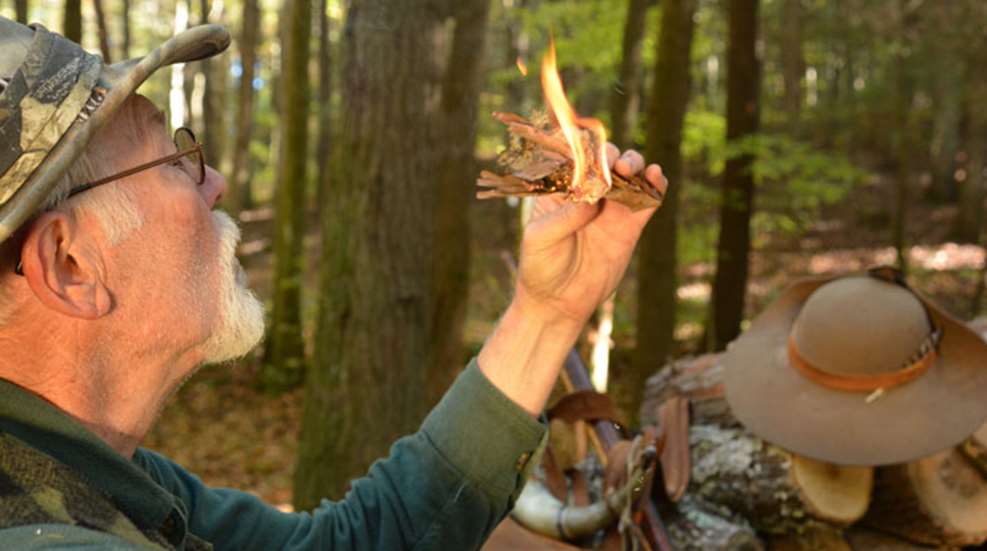
Nobody knows for sure when man first discovered fire. It was probably when some poor hunter stumbled onto a tree that had been hit by lightning. As he sat close and stayed warm through the dark night he was no doubt thinking, “Man, this fire stuff could be handy. It keeps me warm, cooks my food, scares off the big critters trying to eat me and will really impress that pretty woman with the tiger bones in her hair. I wonder how I can create fire on demand?” Or, as he was a rather primitive species named Homo erectus, his thoughts were more likely along the lines of, “Grabbing the pretty light hurts my hand. I should run away.”
Depending on who you believe, man had it figured out as many as 1.7 million years ago, and could start a fire on demand. Fire kept people warm and scared off predators. It tempered rocks, which made making tools and weapons easier. It allowed for the cooking of food, which killed off the creepy-crawly bugs and germs, so it made man healthier. It also made humans good-looking. The early use of fire and cooking made food softer and easier to digest. This allowed Homo erectus to evolve with smaller mouths and teeth, as well much smaller digestive systems. The benefits of evolving to a smaller gut is that they got more dates with pretty cavewomen without doing a lot of crunches.
One way ancient man created fire was by rubbing two sticks together. Actually, they used a single round “drill” on a larger piece of wood. By spinning the drill between their hands with one end on the other piece of wood, they created heat by friction and tinder with the fine sawdust it produces—but that’s all very labor-intensive. Then some smarter (or lazier) caveman noticed banging two rocks together made a spark. That eventually evolved into flint and steel, which kind of became the 18th century’s matchbook. It was easy to put in your pocket and bring fire along with you as you travel, although rumors that the first Holiday Inns gave out flint and steel kits with their logo on them are wholly unsubstantiated.
We have our modern-day version with the Ferro rods that are so popular, throwing more and hotter sparks, but it’s still a good idea to learn the old skills.
Here’s how it’s done according to my good friend Tony Kinton, who is an expert on all that old-timey stuff. (He still insists that smokeless powder is just a passing fad.)
The key to lighting a fire with flint and steel is to understand that the sparks are not all that hot or numerous compared to a Ferro rod. Thus you need to have something that will catch the spark and ignite easily. It’s said the mountain men used punk wood, which is wood found in dead trees at a certain point in the decaying process. It works best if charred first.
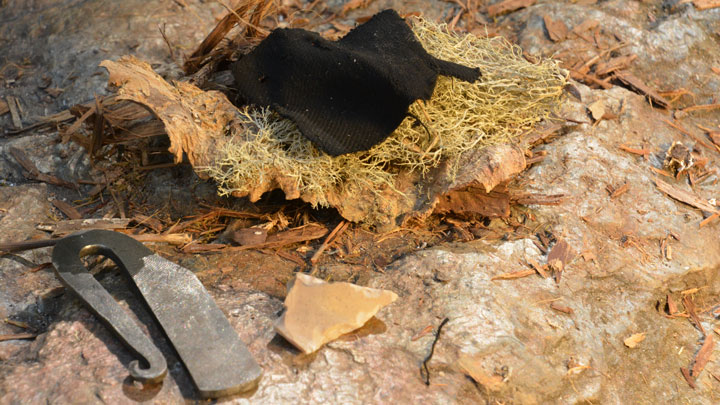
The more common tinder is char cloth, which is coarse, woven cotton fabric charred inside an airtight container until it’s mostly carbon. Most flint-and-steel aficionados carry some char cloth in a waterproof container or tinderbox. (Now you know where that term came from.) Char cloth ignites easily, and the course weave forms nooks and crannies to catch the spark. You can make your own or, of course, buy it online. In fact, everything you need to start a fire like primitive man did is available on the internet. I hope you can see the irony in that.
With building any fire, the key is preparation. It’s best to have everything set up and ready to go. Once you have fire, it will burn fast, and be fleeting. You will not have time to mess around. Everything must be pre-arranged and ready to go.
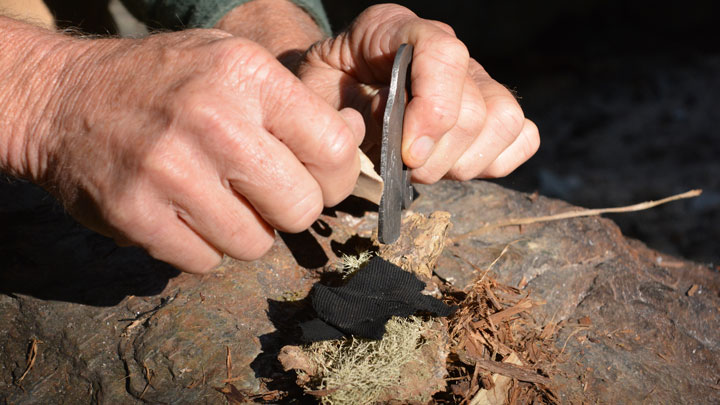
First, build a nest of fine, easy-to burn tinder material. That can be dry grass, pine straw, dried bird nests or strips of birch bark or other tree bark. Also, you must have some small kindling, such as small, dry pieces of wood. Split wood works best, as it has sharp edges to help it light. Pieces of fatwood—which are pine infused with pitch—work great. It should be loosely stacked near the final location for your campfire. Leave an opening to insert the burning nest.
Finally, you will need fuel for the fire, such as larger pieces of wood. Again, it’s important to get all of this gathered and prepared in advance.
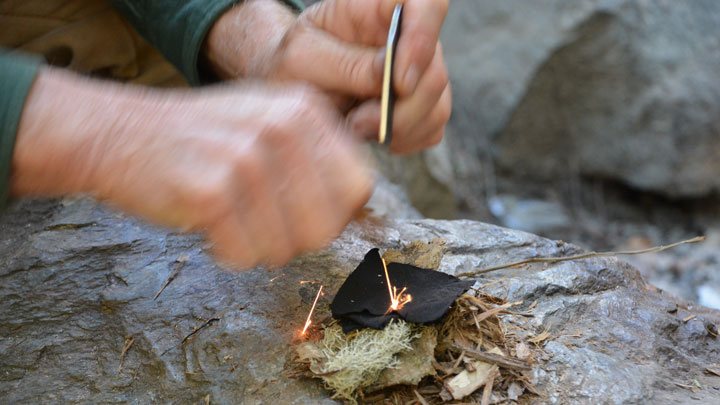
Place your nest of tinder on a dry surface and lay the char cloth on top. Form it just a bit to make a pocket to catch the spark. This is how Tony likes to do it. Others hold the char cloth on their hand or place it on the flint until it ignites. The key is to strike the flint and steel in a way that directs the sparks to the char cloth, so adjust the technique to fit your approach. By holding the char cloth on the top of the flint and striking the flint with a downward motion of the steel, the sparks are directed up and will fall on the char cloth. With Tony’s method, you must make the sparks fall down into the char cloth and the tinder nest. So, simply reverse the motion and strike the flint against the steel.
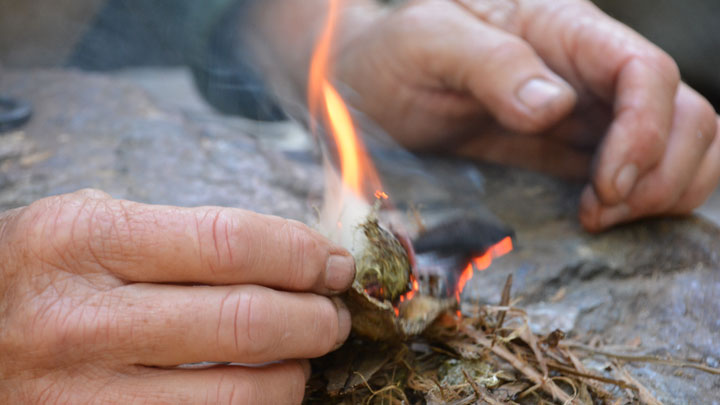
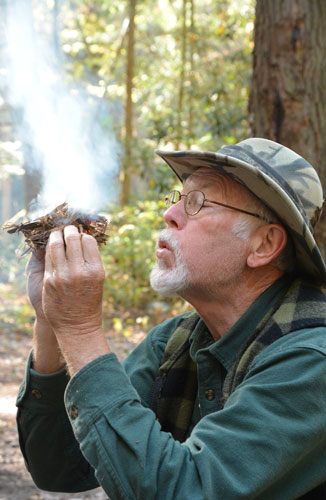
When the char cloth ignites, you’ll note a small spot changing color to ashy gray. Pick up the nest and gently curl it around the burning char cloth. Keep it open and loose to allow easy airflow. Blow lightly on the fire. It can help to hold the nest high so you’re blowing up. The thought is that the moisture in your breath will drop, and the air reaching the fire will be dryer.
Gently coax the burning char cloth into flame, then coax that flame into lighting the dry nest. You may wish to add a bit more tinder for fuel.
You should have already prepared the kindling at your fire location; a teepee-type stack works well. Once the nest is burning well, slide it into the stack. Continue to gently blow and coax the flames until the kindling is ignited and flaming.
Slowly feed larger and larger pieces of fuel into the fire. Be careful not to put too much on and smother the flames. Once the fire is burning well, continue to feed larger pieces of fuel until you have the size fire you desire.
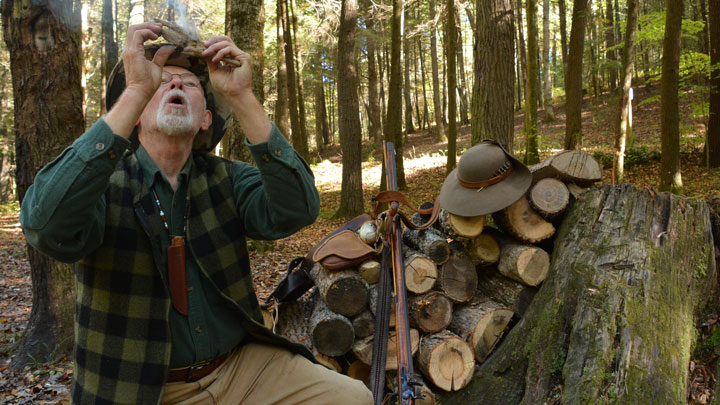
By now the girl with the bones in her hair will be greatly impressed. Pull her close, put your arm around her and stare into the flames, just as the cavemen did a million years ago.
There really is nothing better in life.



































